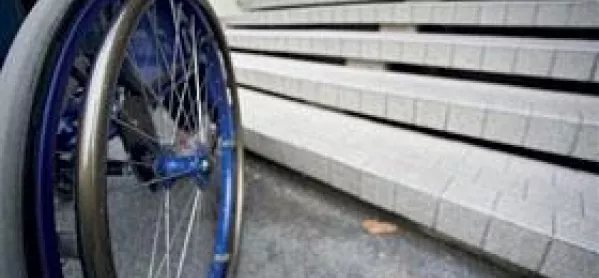Equal access - as long as you’re not disabled

“Shocking” shortcomings in disability access are preventing children from attending their preferred schools because they cannot get into the buildings, new research has revealed.
The findings, from the Scottish Disability Equality Forum, also highlight a startling legal anomaly which means that disabled children in schools do not have the same rights to access as employees.
Although a disabled worker in a bank, for example, has the right to expect provisions to be in place, in a school the onus is on a child’s family to complain about lack of access, rather than on authorities to bring older buildings up to scratch.
The forum requested copies of the accessibility strategies that all local authorities, grant-aided schools and independent schools are required to draw up by law, but only two out of 61 produced a strategy that it rated as “good”. Only 13 replies were received in total, even after requests under the Freedom of Information Act.
“Our research shows that the Scottish legislation which should be increasing access for disabled students is being largely ignored,” said forum chief executive Susan Grasekamp. “There is no doubt that this is resulting in disabled pupils having to go to different schools from their friends and siblings, or having to accept compromises in their education.”
A briefing by the forum, due to be published today, found “particularly concerning” issues around physical access to schools, and a “shocking failure” to fulfil duties around statutory accessibility strategies.
One disabled student was not allowed to attend a secondary school - a four-storey building with no lift - because of mobility problems. Another child was prevented from attending a nursery because it was inaccessible; then at primary school it was found that the council had not installed a necessary stairlift between levels.
“It’s astonishing that, as equalities law stands, a bank is required to modify a branch for a disabled employee or customer, but a school does not have to adapt their building for a disabled pupil,” Ms Grasekamp said.
Accessibility strategies - a legacy of 2002 disability legislation - should identify how children can participate in the curriculum, but the forum said that many were “wish lists” without clear targets. The strategies should also act to improve communication with students, but “very few” demonstrated good practice in this area, the forum said. Overall, it found “systematic failure”, which it said was the responsibility of the whole education system, not any one body.
“We want to see education providers, Education Scotland and the Scottish government taking this legislation seriously and working with local partners to make schools more accessible,” Ms Grasekamp said.
The forum did uncover some good practice, however. Highland was strong in nearly every area of its strategy and went beyond legal duties, while Dundee provided “excellent information” about improvements and consulted well with students. George Watson’s College and St George’s Schools for Girls, in Edinburgh, gave “excellent” reviews of improvements.
A spokesman for local authorities body Cosla said: “The physical school estate is something that councils strive to ensure meets the needs of the 21st century, but there are still some schools across the country that were built in the last century or even before. While councils can and do strive to make the necessary adaptations to deliver equal access in these properties, there will continue to be challenges. Where that is the case, alternative provision will be offered.”
John Edward, director of the Scottish Council of Independent Schools (SCIS), said: “I certainly think, to a greater or less extent, [schools] have done everything that they could have.”
SCIS acknowledged that independent schools were often in older buildings but said the situation would improve after it published an update to a 2006 guide on disability-related issues. This will follow a Scottish government consultation on planning improvements for disabled students’ access to education, which concludes this week.
A government spokeswoman said: “We want all children and young people to get the support they need to reach their full learning potential. Local authorities have a duty to meet pupils’ additional support needs and make reasonable adjustments for disabled pupils.”
An Education Scotland spokeswoman said that every inspection required a school to evaluate itself on inclusion and equality, and that inspectors highlighted any issues around inaccessibility. Education Scotland also evaluated schools’ compliance with legislation.
There were 15,510 disabled students in state schools in 2013, according to government figures, with 2,780 needing physical adaptations of mainstream primary and secondary schools.
Keep reading for just £1 per month
You've reached your limit of free articles this month. Subscribe for £1 per month for three months and get:
- Unlimited access to all Tes magazine content
- Exclusive subscriber-only stories
- Award-winning email newsletters



